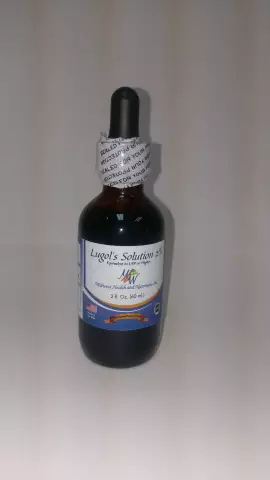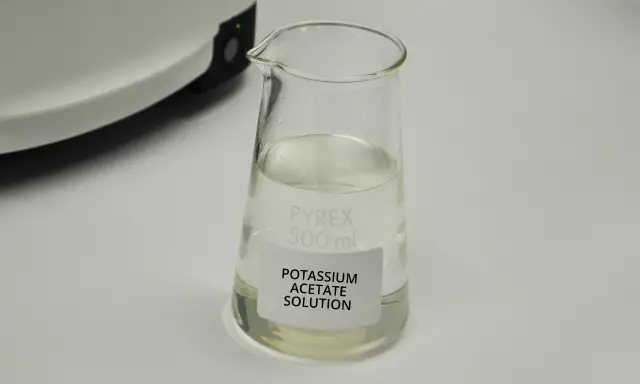- Author Rachel Wainwright [email protected].
- Public 2023-12-15 07:39.
- Last modified 2025-11-02 20:14.
Pyridoxine
Pyridoxine: instructions for use and reviews
- 1. Release form and composition
- 2. Pharmacological properties
- 3. Indications for use
- 4. Contraindications
- 5. Method of application and dosage
- 6. Side effects
- 7. Overdose
- 8. Special instructions
- 9. Application during pregnancy and lactation
- 10. Use in childhood
- 11. For violations of liver function
- 12. Drug interactions
- 13. Analogs
- 14. Terms and conditions of storage
- 15. Terms of dispensing from pharmacies
- 16. Reviews
- 17. Price in pharmacies
Latin name: Pyridoxine
ATX code: A11HA02
Active ingredient: pyridoxine (pyridoxine)
Manufacturer: Yerevan Chemical-Pharmaceutical Firm (Armenia), Moskhimpharmpreparaty named after ON. Semashko, JSC (Russia), Borisov Plant of Medical Products (Republic of Belarus), Pharmstandard-Ufa Vitamin Plant (Russia), Ozon Pharm (Russia), Lvovdialek DP GAK Ukrmedprom (Ukraine), Veropharm (Russia)
Description and photo update: 2019-21-08
Prices in pharmacies: from 25 rubles.
Buy

Pyridoxine is a drug that helps to replenish the lack of vitamin B6.
Release form and composition
Dosage forms of release:
- Tablets (in contoured or non-cell packs of 10 pcs., 1-5 packs in a cardboard box; in dark glass or polymer cans, 50 pcs., 1 can in a cardboard box);
- Solution for injection (in 1 ml ampoules, 5 or 10 pcs. In blisters, 1 or 2 packages in a cardboard box or 10 pcs. In a cardboard box).
The active substance is pyridoxine (in the form of hydrochloride):
- 1 tablet - 10 mg;
- 1 ml solution for injection - 10 or 50 mg.
Pharmacological properties
Pharmacodynamics
Pyridoxine is a vitamin B 6. Entering the body, pyridoxine is phosphorylated and converted into pyridoxal-5-phosphate. It is included in the composition of enzymes that carry out transamination, racemization and decarboxylation of amino acids, as well as enzymatic conversion of hydroxylated and sulfur-containing amino acids.
Pyridoxine is essential for the normal functioning of the central and peripheral nervous system. Participates in the metabolism of cysteine, methionine, tryptophan, glutamic and other amino acids. Promotes the normalization of lipid metabolism. Plays an important role in the exchange of histamine.
Isolated deficiency of vitamin B 6 is very rare, mainly in children who eat a special artificial diet. Lack of pyridoxine is manifested by diarrhea, anemia, seizures, in some cases leads to the development of peripheral neuropathy.
The daily requirement for vitamin B 6: adults - 2-2.5 mg, boys 14-17 years old - 2.2 mg, girls 14-17 years old - 1.9 mg, teenagers 11-13 years old - 2 mg, children aged 7-10 years - 1.7 mg, 5-6 years - 1.4 mg, 3-4 years - 1.3 mg, 1.5-2 years - 1 mg, from 1 to 1.5 years - 0, 9 mg, from 6 months to 1 year - 0.5 mg. Women are advised to receive 2 mg / day, additionally during pregnancy - 0.3 mg, while breastfeeding - 0.5 mg.
Pharmacokinetics
Pyridoxine is metabolized in the liver, resulting in the formation of pharmacologically active metabolites pyridoxamine phosphate and pyridoxal phosphate.
It is characterized by a high bond with plasma proteins - 90%. It is well absorbed throughout the entire small intestine, absorbed in large quantities and penetrates into all tissues. It is distributed mainly in the liver, to a lesser extent in the central nervous system and muscles. Penetrates through the placenta and into breast milk.
It is excreted by the kidneys (when administered intravenously, 2% is excreted in the bile). The half-life is 15-20 days. It is excreted during hemodialysis.
Indications for use
According to the instructions, Pyridoxine is used for the prevention and treatment of hypo- and vitamin deficiency B 6.
As part of complex therapy, the drug is prescribed for the following diseases:
- diseases of the nervous system: seasickness and air sickness, paralysis of central or peripheral origin, neuritis, neuralgia, sciatica, Little's disease, parkinsonism, Meniere's disease and syndrome;
- dermatological diseases: neurodermatitis, psoriasis, shingles, dermatitis (including seborrheic), exudative diathesis, etc.;
- acute and chronic hepatitis, alcoholism;
- toxicosis of pregnant women: anemia (microcytic, hypochromic, sideroblastic);
- congenital pyridoxine-dependent convulsive syndrome of newborns.
Pyridoxine is also prescribed to increase urine output and enhance the action of diuretics, prevent and treat the neurotoxicity of isoniazid or other anti-tuberculosis drugs.
Contraindications
Pyridoxine tablets and solution in ampoules are contraindicated in the presence of hypersensitivity to the components of the drug.
In patients with gastric ulcer and duodenal ulcer and ischemic heart disease, caution should be exercised when prescribing the drug.
Instructions for the use of Pyridoxine: method and dosage
The recommended dosage regimen for adults with vitamin B6 deficiency:
- Tablets: single dose - 80 mg, frequency of administration - 4 times a day;
- Solution for injection (subcutaneously, intravenously or intramuscularly): daily dose - 50-150 mg.
The duration of the course is determined by the doctor on an individual basis.
For prevention, the drug is prescribed in a daily dose of 40 mg.
Side effects
In some cases, during the period of use of the drug, disorders in the form of allergic reactions and hypersecretion of hydrochloric acid may develop.
Overdose
No information available.
special instructions
When high doses of Pyridoxine are prescribed in patients with severe liver damage, deterioration of its function may be observed.
Influence on the ability to drive vehicles and complex mechanisms
There are no reports of adverse effects of vitamin B 6 on reaction speed and concentration.
Application during pregnancy and lactation
Pyridoxine can be used during pregnancy and lactation as directed by a doctor.
Pediatric use
There are no age restrictions for the use of the drug. Pyridoxine is approved for use from birth.
For the treatment of pyridoxine-dependent convulsive syndrome in newborns, Pyridoxine in ampoules is administered intravenously or intramuscularly at a dose of 100 mg. For other indications, children are prescribed 20 mg of pyridoxine (0.5 ml of a 5% solution) per day for 2 weeks.
Pyridoxine tablets are prescribed for prophylactic and therapeutic purposes in accordance with the recommendations according to age.
For violations of liver function
The drug should be used with caution in severe liver damage, since vitamin B 6 in high doses can cause deterioration of its function.
Drug interactions
With the simultaneous use of certain substances / drugs, the following effects may develop:
- Diuretics: their action is potentiated;
- Penicillamine, isonicotinhydrazide, cycloserine: the effectiveness of pyridoxine hydrochloride decreases;
- Levodopa: its effects are reduced or completely inhibited;
- Phenytoin, phenobarbital: their concentration in blood plasma decreases;
- Hormonal contraceptives: the concentration of pyridoxine hydrochloride in blood plasma increases.
Analogs
Pyridoxine analogs are: Pyridoxine hydrochloride, Pyridoxine bufus, Pyridoxine-Vial.
Terms and conditions of storage
Store in a dry, dark place, out of reach of children, at a temperature not exceeding 25 ° C.
The shelf life is 3 years.
Terms of dispensing from pharmacies
Dispensed by prescription.
Reviews about Pyridoxine
On forums and specialized medical sites, there are mostly positive reviews about Pyridoxine. This vitamin is very often used in the complex therapy of various diseases, and patients note that it significantly improves the therapeutic effect.
Many patients take a course on their own to increase immunity, strengthen the nervous system, strengthen hair and nails. They pay attention to a good result, despite the low cost of the drug: stamina and mood increase, hair and nail growth accelerates, hair and skin condition improves, and nails become stronger.
Among the large number of positive reviews, occasionally there are negative messages that contain complaints about the development of side effects when taking Pyridoxine tablets, such as increased acidity of gastric contents and pain and abdominal pain. Experts in this case emphasize: the instructions for the drug indicate that it can cause hypersecretion of hydrochloric acid, and this should be taken into account in patients with gastric ulcer and duodenal ulcer. In rare cases, the drug causes allergic reactions, but they usually go away on their own after you stop taking the pills.
The price of Pyridoxine in pharmacies
Approximate prices of Pyridoxine: 50 tablets of 10 mg - 35-66 rubles, 10 ampoules of 5% solution of 1 ml - 23-36 rubles.
Pyridoxine: prices in online pharmacies
|
Drug name Price Pharmacy |
|
Pyridoxine 50 mg / ml injection 1 ml 10 pcs. RUB 25 Buy |
|
Pyridoxine 10 mg tablets 50 pcs. RUB 25 Buy |
|
Pyridoxine 50 mg / ml injection 1 ml 10 pcs. RUB 29 Buy |
|
Pyridoxine 50 mg / ml injection 1 ml 10 pcs. RUB 29 Buy |
|
Pyridoxine 50 mg / ml injection 1 ml 10 pcs. RUB 31 Buy |
|
Pyridoxine 50 mg / ml injection 1 ml 10 pcs. 32 RUB Buy |
|
Pyridoxine tablets 10mg 50 pcs. RUB 47 Buy |

Maria Kulkes Medical journalist About the author
Education: First Moscow State Medical University named after I. M. Sechenov, specialty "General Medicine".
Information about the drug is generalized, provided for informational purposes only and does not replace the official instructions. Self-medication is hazardous to health!






